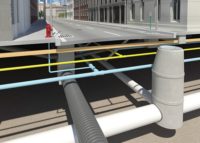Recently, Lean Construction has been celebrated as the new fad among construction-management gurus. In reality, it is not the leanness of the construction that matters but rather its agility and responsiveness to change. That is why the National Institute of Standards and Technology and ASTM International are working on draft productivity protocols that support a new process called Agile Construction.
One of the most misunderstood concepts in the construction industry is the difference between profitability and cash flow. Due to the nature of accounting principles used to manage company profitability, most measurements of job progress really are measurements of production, not productivity. This distinction has a direct impact on the cash flow of both the project and the company. Recognition of the distinction between production and productivity will help contractors become much more agile in their responses to a jobsite’s changing needs.

DANESHGARI
Much of the distinction is based on tax law. In the Tax Reform Act of 1986, construction law was changed to help contractors better manage their financial assets and cash flow through progress billings. Previously, revenue was recognized only at project completion, which caused cash-flow problems and essentially forced contractors to subsidize most of the work, leading in many cases to bankruptcy.
Further tax legislation promulgated via the Technical and Miscellaneous Revenue Act (TAMRA) of 1988 enabled contractors to process bills based on either a cost basis, unit price or observed percent age of completion. Due to the lack of objective methodology, progress billing is most often cost-based. According to the Construction Financial Management Association’s 2007 annual report, up to 89% of all contractors in the U.S. base their billings on cost. This method leaves much to be desired.
In Agile Construction, a tracking system that is driven by jobsite dynamics and compatible with building information modeling (BIM) systems supports progress billing based on actual construction put-in-place (CPIP). Until recently, CPIP measurement was not easily achievable, but a new methodology called Job Productivity Measurement (JPM), based on the application of statistical process control, is now available and being used as the basis for the developing ASTM standard.
Agile Construction recognizes the bottom-line impact of three sources of cost drivers: money, materials and manpower. Visible means of measuring job progress, labor productivity, profitability, cash flow and materials handling enable an Agile Construction company to effectively apply BIM as part of its daily project operations.
Responsiveness to the changing jobsite environment is the key to profitability for any contractor. Profitability results from operating as a low-cost provider. But to be a low-cost provider, contractors need to know the situation, its cost drivers and its productivity. To manage profits, the costs need to be visible. Correct allocation of a contractor’s fixed costs to the customer, project, subcontractors and resources will allow the contractor to be more agile and profitable.
Contractors that apply daily or weekly agile job tracking will be able to improve their cash flow and profitability. Since TAMRA allows contractors to bill the larger of the recognized revenue based on cost or observed percentage of completion, contractors are able to better manage their cash flow by connecting the CPIP measurements to the project.
Managing projects based just on costs results in unpredictable outcomes. Contractors often have to wait until the end of the job to find out whether expected profits will be earned. As a result, using accounting data without really knowing project productivity does little to help contractors improve their cash flow and profitability. Billing based only on costs leaves productivity on the table. Correctly measuring the job allows the contractor to switch from using only the rearview mirror of cost accounting to using the rearview mirror in conjunction with the full front view through the windshield of JPM.
The bottom line is that the only useful measurement of productivity is the one that will allow instantaneous correction in the field, hence the development of JPM for ASTM as a standard practice.



Post a comment to this article
Report Abusive Comment